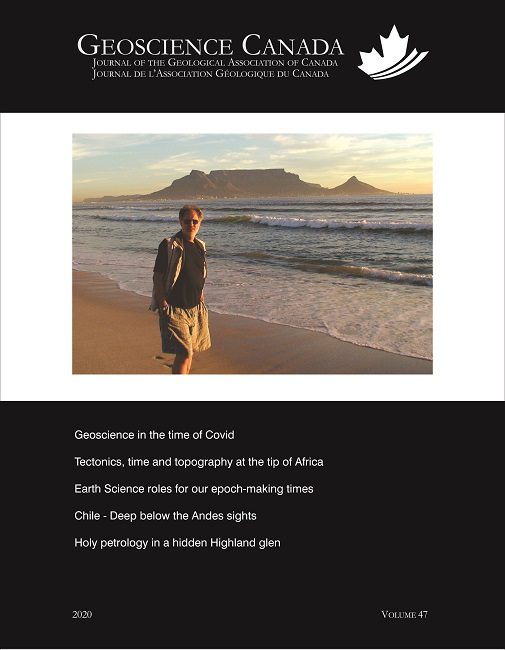Proterozoic–Paleozoic Sedimentary Rocks and Mesozoic–Cenozoic Landscapes of the Cape Mountains Across the Kango Complex Reveal ‘More Gaps Than Record’ from Rodinia and Gondwana to Africa
Publié-e 2020-07-10
Comment citer
Résumé
The Kango (Cango) region flanks the northern margins of the Klein Karoo and the Cape Mountains across the Western Cape Province of South Africa. It preserves a condensed Proterozoic–Paleozoic stratigraphy exposed via a Mesozoic–Cenozoic morphology with a present Alpine-like topography. Its rocks and landscapes have been repeatedly mapped and documented for the past 150 years. Over the last 25 years, we remapped and dated a central-eastern section of this region. The subvertically bedded and cleaved rocks reveal an 8–10 km thick stratigraphy covering more than 700 million years between ca. 1200 and 500 Ma with several unconformities and disconformities. At ca. 252 Ma, during the Cape orogeny, this Kango Complex was deformed along thrusts and sub-isoclinal folds producing steeply dipping phyllites and slates. It was uplifted by 3–5 km during the Kalahari epeirogeny between 140 and 60 Ma while eroding at ca. 100–200 m/m.y. (120–80 Ma). During the Cenozoic, the rate of uplift decreased by an order of magnitude and today is ca. 0.4–0.7 m/m.y. across steep slopes and canyons in contrast to the Himalayas where erosion rates are about hundred times faster. A recent publication about this central-eastern section of the Kango region disputes the existence of regional isoclinal folds and suggests that deposition of the oldest sedimentary successions, including carbonate rocks of the Cango Caves (limestone-marble with enigmatic microfossils) was simple, continuous and restricted to between ca. 700 and 500 Ma, decreasing earlier estimates of the stratigraphic age range by 60–80%. Similarly, recent interpretations of the complex landscapes link the northern contact between the Kango and Table Mountain rock sequences to Quaternary faults. We present a new geological database, mapped between 1:500 and 1:10,000 scales, and twelve stratigraphic sections with younging directions linked to structural and isotopic data that support repetitions along regional isoclinal folds and thrust zones of the Kango sequences during the Permo–Triassic Cape orogeny, and geomorphic data that link the origin of its landscapes to weathering and erosion during the Cretaceous–Cenozoic Kalahari epeirogeny. During its evolution, the Kango Basin directly flanked both Grenvillian and Pan-African Mountain systems. But, at an average sedimentation rate of ca. 1 mm/70 years (0.014 mm/year) and with present low erosion rates (0.005 mm/year), there is likely more time missing than preserved of the tectono-erosion across these different regions of Rodinia and Gondwana before Africa emerged. To further evaluate the geodynamic significance of these time gaps requires more field mapping linked to new transdisciplinary geosciences.
RÉSUMÉ
La région du Kango (Cango) flanque les marges nord du petit Karoo et des montagnes du Cap dans la province du Western Cape en Afrique du Sud. Elle préserve une stratigraphie condensée protérozoïque–paléozoïque exposée via une morphologie mésozoïque–cénozoïque avec une topographie actuelle de type alpin. Ses roches et ses paysages ont été cartographiés et documentés durant les 150 dernières années. Au cours des 25 dernières années, nous avons re-cartographié et daté une section du centre-est de cette région. Les roches litées de manière subverticale et clivées révèlent une stratigraphie de 8 à 10 km d'épaisseur couvrant plus de 700 millions d'années entre environ 1200 et 500 Ma avec plusieurs non-conformités et disconformités. À 252 Ma, au cours de l'orogenèse du Cap, ce Complexe du Kango s'est déformé le long de chevauchements et de plis isoclinaux produisant des schistes à fort pendage. Il a été soulevé de 3 à 5 km au cours de l'épirogenèse du Kalahari entre 140 et 60 Ma, tout en s'érodant à 100–200 m/m.a. (120–80 Ma). Pendant le Cénozoïque, le taux de soulèvement a diminué d'un ordre de grandeur et il est aujourd'hui d'environ 0,4 à 0,7 m/m.a. à travers des pentes abruptes et des canyons, contrairement à l'Himalaya où les taux d'érosion sont environ cent fois plus rapides. Une publication récente sur cette section du centre-est de la région du Kango conteste l'existence de plis isoclinaux régionaux et suggère que le dépôt des plus anciennes successions sédimentaires, y compris les roches carbonatées des Grottes du Cango (marbre calcaire avec des microfossiles énigmatiques) était simple, continu et limité entre environ 700 et 500 Ma, diminuant les estimations antérieures de la tranche d'âge stratigraphique de 60-80%. De même, des interprétations récentes des paysages complexes relient le contact nord entre les séquences rocheuses du Kango et de Table Mountain à des failles quaternaires. Nous présentons une nouvelle base de données géologiques, cartographiée à des échelles entre 1:500 et 1:10,000, et douze coupes stratigraphiques avec des directions de superposition liées à des données structurales et isotopiques qui concordent avec les répétitions le long des plis isoclinaux régionaux et des zones de chevauchement des séquences du Kango pendant l’orogenèse permo–triassique du Cap, et des données géomorphiques qui relient l'origine de ses paysages à l’altération et à l'érosion au cours de l'épirogenèse du Kalahari au Crétacé–Cénozoïque. Au cours de son évolution, le bassin du Kango flanquait les systèmes montagneux grenvillien et panafricain. Mais, à un taux de sédimentation moyen d’environ 1 mm/70 ans (0,014 mm/an) et avec les faibles taux d'érosion actuels (0,005 mm/an), il manque probablement plus d’enregistrements de la tectonique et érosion de ces différentes régions de Rodinia et Gondwana avant l'émergence de l'Afrique que ce qui est actuellement préservé. Pour évaluer la signification géodynamique de ces intervalles de temps manquant, il faut d’avantage de cartographie de terrain associée à de nouvelles géosciences transdisciplinaires.
